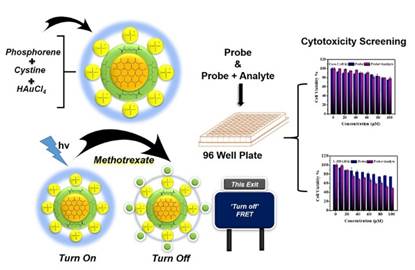
A new highly fluorescent material with exceptional optical properties has been developed using phosphorene, cystine, and gold (Ph-Cys-Au) which can be used as a visual sensing platform for detecting anti-cancer drug MTX overdosage of which has toxic effect on lungs, stomach, and heart.
Monitoring therapeutic drugs and their elimination is crucial because they may cause severe side effects on the human body. Methotrexate (MTX) is a widely used anti-cancer drug.
The MTX value of more than 10 µM in blood plasma is hazardous if it remains in the system for more than 10 hours, resulting in poisoning effects on the lungs, ulcers of the stomach, and heart stroke.
MTX is highly expensive, and the detection of unwanted overdoses using traditional procedures is time-consuming and involves complex instrumentation. Considering all these issues, the development of fast and sensitive detection using simple methodologies is required.
To address this issue, scientists of Institute of Advanced Study in Science and Technology (IASST), an autonomous institute of Department of Science and Technology (DST) have developed a highly fluorescent material using phosphorene, cystine, and gold (Ph-Cys-Au).
The material by the the team consisting of Professor Neelotpal Sen Sarma, Dr. Mojibur R Khan, and research scholars Nasrin Sultana and Chingtham Thanil Singh, has exceptional optical properties and thus can be used as a visual sensing platform for detecting the anti-cancer drug MTX.
This non-enzymatic approach for the detection of anticancer drug Methotrexate can help cytotoxicity screening for therapeutic analysis.
The developed sensing platform outperforms all former systems as the materials are biocompatible with an appreciable detection limit, the official communique of Union Ministry of Science and Technology said.
The material shows a detection limit of about 0.0266 nM (for a linear range of 0–140 µL) and 0.0077 nM (for a linear range of 160–260 µL). This work has been published recently in RSC Nanoscale, 2023, 15, 17570.
Moreover, the nanocomposite exhibited in vitro cytotoxicity towards cancerous cells, but it was non-cytotoxic for non-cancerous cells.



